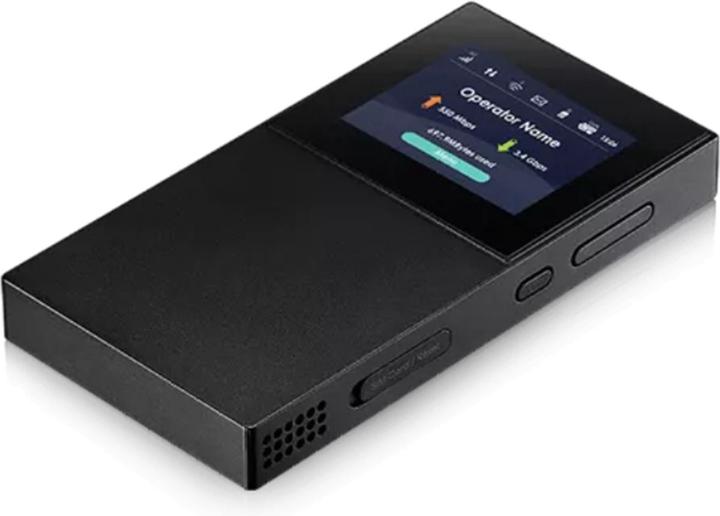

Three travel routers compared: always have your WLAN with you
Just insert the SIM card, and I have WLAN for my devices on the move. Mobile routers are ideal for work and family vacations. But is the investment really worth it?
Travelling without Wi-Fi is like a backpack without provisions – you can do it, but you’ll feel unprepared. It’s worth having enough provisions and Wi-Fi in your bag, especially if you’re with a family or in a group.
All you need is a mobile router and a SIM card. You can get these either at home with low roaming prices or directly abroad – often at significantly lower prices than mobile internet.
For this comparison, I tested three popular yet very different models from our range. I award a maximum of five points per device in each discipline. In the conclusion, I’ll also tell you which router is suitable for whom – and whether your own cell phone isn’t simply sufficient as a hotspot.
Price: routers are very expensive
TP-Link M7650:: at CHF 123 at time of testing, the TP-Link model is the cheapest model in this comparison.
🧹🧹🧹🧹🧹

Zyxel NR2301: the Zyxel router costs 209 francs and is in the mid-range price bracket. 🧹🧹🧹🧹
Netgear Nighthawk M6 Pro: pricing is the biggest weakness of Netgear’s top model. It costs 816 francs, and is significantly more expensive than the competition as a result. 🦸
Unboxing and operation: too many buttons left out
TP-Link M7650: one positive surprise during unboxing – I can replace the router’s battery. It’s just a shame that the router itself can’t be operated with a mains connection and the battery removed. The cheap back cover and outdated micro-USB port are other drawbacks. There’s also no charger. I can only insert my nano SIM card with an adapter, which is included. It’s operated with two buttons, which requires a lot of clicking and feels tedious. The small screen is sufficient for an overview. 🦸🦸
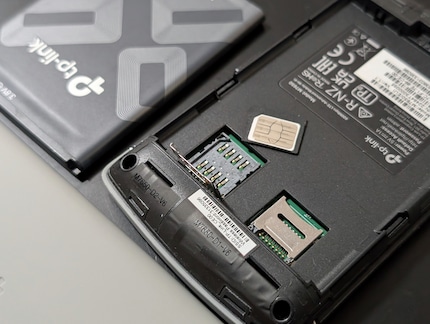
Source: Lorenz Keller
Zyxel NR2301: in its plain cardboard box, I only find a USB cable, but no charger. The battery is permanently installed by the manufacturer, and I can insert the nano SIM card on the side. There are only two buttons to change settings in the menus. That also feels too minimalist and tricky to me. At least the screen is large enough and easy to read. 🦸🦸🦸
Netgear Nighthawk M6 Pro: Netgear is the only manufacturer to supply a charger, which it also equips with a UK adapter. The battery of the Nighthawk can be replaced and doesn’t need to be in the device for direct operation. To change the SIM card, I always have to remove the cover on the back of the device and take out the battery. Setting it up is child’s play since I’m guided through the process step by step directly on the touchscreen. 🧹🧹🧹🧹🧹
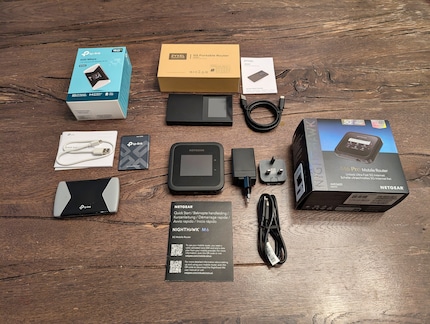
Source: Lorenz Keller
Features: the more expensive, the more features
TP-Link M7650:
- 4G mobile communications up to 0.6 Gbit
- Supply a maximum of 32 devices with WLAN
- SD card slot to share up to 32 GB of memory with the connected devices 🦸🦸
Zyxel NR2301:
- 5G mobile communication up to 3.4 Gbit/s, 4G LTE up to 1.6 Gbit/s
- Support for WiFi6
- Supply a maximum of 32 devices with WLAN
- TS9 sockets for external antennas 🦸🦸🦸
Netgear Nighthawk M6 Pro:
- 5G mobile communication up to 4.0 Gbit/s, 4G LTE up to 1.6 Gbit/s
- Support for WiFi6e
- Supply a maximum of 32 devices with WLAN
- TS9 sockets for external antennas
- 2.5 Gigabit Ethernet port 🧹🧹🧹🧹🧹
Installation: a touchscreen makes all the difference
The good news: all three devices already have WLAN access pre-set. This is helpful for getting started. Of course, you can customise it yourself, which I strongly recommend. The manual or a tech-savvy acquaintance will be happy to help you.
TP-Link M7650: the preset Service Set Identifier (SSID) is only secured by a numerical code. This makes initial setup easier, but it doesn’t feel particularly secure. Alternatively, devices can be connected via Wi-Fi Protected Setup (WPS). I can set up either a 2.4 GHz or a 5 GHz network for data transmission. Automatic switching isn’t possible. Roaming abroad can be switched on and off directly on the device. Further settings are made via the tpMiFi app or the web configurator. Configuration via the clearly laid out app is particularly useful when you’re travelling. 🦸🦸🦸
Zyxel NR2301: the router comes with a preset SSID and secure password. Thanks to the QR code displayed on the screen, I can connect cell phones and tablets without having to type. Zyxel also offers WPS. I can choose whether I want to use the 2.4 GHz network and the 5 GHz network individually, together or at the same time. Roaming mode has to be switched on in the menu for use abroad. Unfortunately, the quick guide doesn’t explain this to me any more than how to connect to the web configurator. As the QR code for the support page doesn’t work either, I have to find the manual online myself. If I manage the router via a browser, I can activate features such as the firewall or change details such as the network settings. You can also set a new name and password for the WLAN here.
🦸🦸
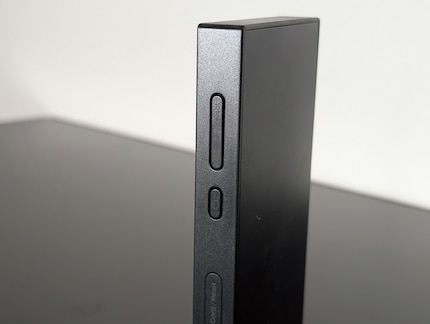
Source: Lorenz Keller
Netgear Nighthawk M6 Pro: thanks to a large touchscreen, the router is easier to configure than its two competitors. From the very start, I can set my own WLAN name and password directly on the router. The Nighthawk offers all basic functions such as WPS or band selection, but I can also reduce the power of the WLAN to save battery or, conversely, increase the range of its wireless internet at the expense of the battery. I can also set up a guest WLAN with just a few clicks. In addition, on-site internet can also be integrated wirelessly or via cable. 🧹🧹🧹🧹🧹
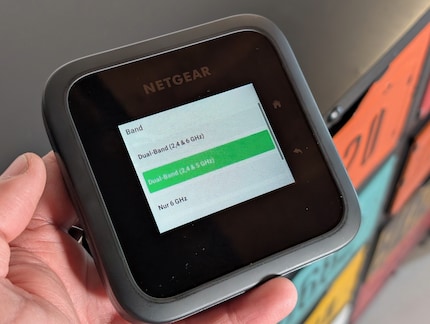
Source: Lorenz Keller
Battery: almost nine hours of continuous surfing
For this test, I connected two smartphones to the router and continuously streamed YouTube in the best possible resolution on both devices.
TP-Link M7650: after around eight hours and 45 minutes of continuous streaming, the battery of the cheapest router is empty. The second-best value among the three. 🧹🧹🧹🧹
Zyxel NR2301: the Zyxel NR2301 would’ve cracked the nine-hour mark with just a few minutes more. Nevertheless, it lasts the longest in my test. 🧹🧹🧹🧹🧹
Netgear Nighthawk M6 Pro: the battery in the Netgear lasts just under eight hours. That’s fine, but still around an hour worse than its two competitors. 🦸🦸🦸
Reception and WLAN: no miracles when reception’s poor
In their first real run, the three routers have to prove themselves on an Italian vacation with quite poor reception. For comparison, I also use an iPhone 16 Pro as a hotspot. The smartphone can quickly set up a Wi-Fi network for other devices.
During my test, I connected each router to two different smartphones and took a dozen measurements each to obtain a reliable average value. For the first comparison, the smartphones and routers were all located in the same room.
TP-Link M7650: the download rates are significantly worse than with its two competitors and hardly better than the iPhone. 🦸
Zyxel NR2301: the Zyxel router surprises me with the best download rates and achieves significantly higher speeds than the smartphone hotspot. However, if you need to upload files, the speed is just as slow as with all other devices. 🧹🧹🧹🧹
Netgear Nighthawk M6 Pro: the download rates are significantly better than with the hotspot, but worse than with the Zyxel. On the other hand, Netgear achieves the best upload rates – even then, they’re still low. 🦸🦸🦸
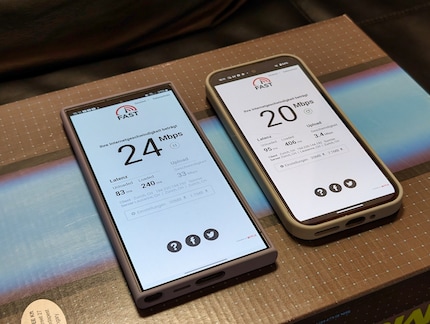
Source: Lorenz Keller
For my second series of tests, I left the router in place in the living room and measured the reception two rooms away. The WLAN signal has to pass through a kitchen and two walls before it reaches the end device.
TP-Link M7650: now even the cheapest router can stand out from an iPhone hotspot. The WLAN network is significantly stronger, and there are only minor losses compared to the measurement in the same room. However, it still ends up slower than its pricier competitors. 🦸🦸
Zyxel NR2301: the Zyxel manages to maintain its speed over a greater distance without any problems. Here, too, some data throughput is lost on the way through our home – only a bit, however. 🧹🧹🧹🧹
Netgear Nighthawk M6 Pro: the M6 Pro offers the best WLAN network. It doesn’t matter where in the flat I measure, I get the same solid performance everywhere. Any data that arrives at the router is also forwarded evenly over a greater distance. 🧹🧹🧹🧹
By the way, Netgear also offers a suitable external antenna for its router. However, I didn’t see any significant improvement in reception when I tested it.
With good reception, the expensive routers come up trumps
I take my last measurements in a Swiss urban environment offering 5G reception. Once again, I calculated average values from a dozen measurements for each router.
TP-Link M7650: the cheapest router disappoints me here. Its lack of 5G reception is noticeable, download and upload speeds are significantly lower than those of the competition. The TP-Link device is also clearly inferior to the iPhone as a hotspot. 🦸
Zyxel NR2301: the Zyxel device surprises with good download values that even keep up with the priciest model. The router also enables significantly faster internet than a smartphone hotspot. 🧹🧹🧹🧹
Netgear Nighthawk M6 Pro: the most expensive router achieves the best results with good 5G reception. However, its performance differs only minimally from the Zyxel. 🧹🧹🧹🧹
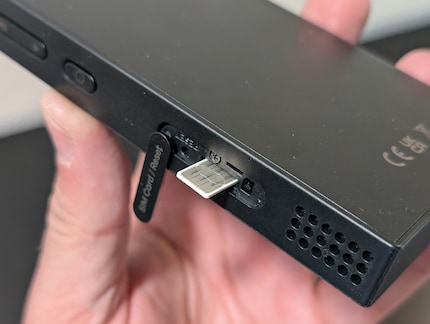
Source: Lorenz Keller
Verdict: the winning model doesn’t have the most points
If I add up all the points, the Netgear router wins with 30, just ahead of the Zyxel router with 29 points. The TP-Link comes a distant third with 20 points.
But the whole thing isn’t that clear-cut. For me, the Zyxel wins out because it offers very good performance at a fair price. True, there are also good reasons to spend considerably more money – or to opt for the cheapest model.
TP-Link M7650: the least expensive model can be a good choice if you primarily use it in countries without 5G reception and you don’t want to drain your smartphone battery with hotspot use.
Zyxel NR2301: the Zyxel router offers a good mix of fair price and high performance. This should be the ideal solution for most users.
Netgear Nighthawk M6 Pro: the top model from Netgear may be expensive, but it also shows clear strengths with the most powerful WLAN network and additional settings. For example, if you need special security features such as blocking certain IP addresses, it’s a good choice. The Netgear is also the only router in my test with an RJ45 connection.
Smartphone hotspot: overall, the two pricier models have a clear speed advantage over a normal smartphone hotspot. However, don’t expect miracles. If there’s poor mobile reception, the portable routers will get the most out of it – but nothing more. Bear in mind, a smartphone hotspot can barely be configured, its range is limited and the battery drains quickly. If none of this plays a major role (e.g. it’s only for occasional use), there’s no reason not to use your everyday smartphone or an older second device as a hotspot.
Good preparation is half the battle – the rest is improvisation. Whether you’re packing provisions or setting up WLAN.
Gadgets are my passion - whether you need them for the home office, for the household, for sport and pleasure or for the smart home. Or, of course, for the big hobby next to the family, namely fishing.
Practical solutions for everyday problems with technology, household hacks and much more.
Show all